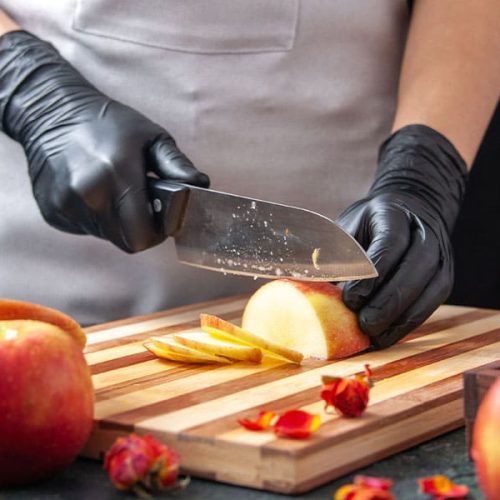Table of Contents
Introduction
If I say kitchen brings happiness to our life, most of us will smile and say yes. A good food makes us happy and if it’s otherwise we feel bad. The story of our favorite dish in the kitchen starts from preparation. A process which is prone to cuts/injuries as it involves use of knives, graters and other sharp tools. Although we want to prepare and enjoy the best food but none of us wants to expose himself or his loved ones working in the kitchen to cuts and injuries. To mitigate this threat of injury, there is no better option than Kitchen gloves for safe cutting. This article will help you understand:
- Importance of Kitchen gloves for safe cutting
- Choosing right kitchen gloves for safe cutting
- Care and Maintenance of Kitchen Gloves for Safe Cutting
- Proper Usage Guidelines
- Comparing Different Brands and Models
- Frequently Asked Questions (FAQs)

Photo is curtesy of pexels.com
Importance of Kitchen gloves for safe cutting
To appreciate the importance of kitchen gloves, I just asked a simple question on Google “How many people get injured by kitchen knives each year?” And answer was 350,000 people get injured by kitchen knives each year. These accidents can lead to deep cuts, lacerations, and even amputations. Common causes of accidents in the kitchen include slippery hands, distractions, and improper handling of knives. This highlights the need for protective gear that can act as a barrier between your hands and potential hazards.
Choosing the Right Kitchen Gloves for safe cutting
While choosing a right or wrong thing the deciding factor remains knowledge. The more you know about anything you want to buy the better would be your decision, so is the case with kitchen gloves for safe cutting.
Features and Technologies in Cutting Gloves
- Microfiber technology:
Cutting gloves equipped with microfiber technology provide enhanced grip and dexterity. This allows for precise cutting, reducing the risk of accidental slips. Cut-resistant gloves are made of a synthetic material, such as:
Kevlar is a synthetic fiber commonly used in body armor manufacturing due to its strength and durability. It can provide great protection against knife threats as the tightly woven fibers are difficult to puncture and can deflect slashing attacks as well.
Dyneema Composite Fabric (DCF), also known as Cuben Fiber (CTF3), is a high-performance non-woven composite material used in high-strength, low-weight applications. It’s an excellent performer against sharp utensils.
HPPE (polyethylene), or fiberglass. HPPE stands for high-performance polyethylene. The term applies to the material used to make the gloves.
- Anti-slip coatings:
Anti-slip coatings on kitchen gloves, further reinforces your grip on slippery surfaces. This feature multiplies control for safe cutting while handling sharp knives.
- Reinforced finger protection:
Look for gloves that offer extra layers of protection for your fingers, as these are the most vulnerable areas during knife handling. This added safety measure can safe cutting while you work.
- Level of protection:
The ANSI system classifies gloves with nine levels of cut protection. A higher number indicates that the glove’s material required a higher weight to penetrate it with a sharp blade.
ANSI Cut Resistant Level Reflects Grams of Weight Needed To Cut Through Material
A1: Greater than 200.
A2: Greater than 500.
A3: Greater than 1000.
A4: Greater than 1500.
A5: Greater than 2200.
A6: Greater than 3000.
A7: Greater than 4000.
A8: Greater than 5000.
- Sizing and fitting:
Proper glove size is crucial for optimal protection. Ill-fitting gloves may hinder your dexterity and compromise your safety. Take accurate measurements of your hand and refer to the manufacturer’s sizing chart to find the best fit.
Tips for Hand measurement
Measure your hand accurately and refer to the manufacturer’s sizing chart for the best fit. Do ascertain which one is your dominant hand. The reason for this is because dominant hand is typically larger due to increased muscle mass. Use measuring tape to measure your hand’s circumference, below your knuckles (excluding your thumb). For those measuring with a string, you’ll need to mark how much is required to go around your hand. Record your measurement in inches. For string calculators, take the string and align only the amount that covered your hand next to the ruler. That is your glove size!
Care and Maintenance of Kitchen Gloves for Safe Cutting
To ensure long life and optimal protection by your kitchen gloves for safe cutting, it’s essential to follow proper care and maintenance procedures. Here are some guidelines to keep in mind:
- Washing and drying:
Regularly wash your gloves according to the manufacturer’s instructions to maintain cleanliness and hygiene. Get gloves fully dry before using them again to prevent the growth of bacteria or unpleasant odors.
- Storage:
Store your gloves in a clean and dry place, away from direct sunlight or extreme temperatures.
Avoid stacking heavy objects on top of them to prevent unnecessary wear and tear.
- Periodic inspection and replacement:
Regularly inspect your gloves for any signs of wear, tear, or damage. Replace them when necessary to ensure their effectiveness in providing protection.

Photo is curtesy of pexels.com
Proper Usage Guidelines
The manual containing information about usage of kitchen gloves for safe cutting is very important to get maximum protection and life of gloves. Few guidelines are provided as under:
- Correct hand placement and finger positioning
When wearing kitchen gloves, ensure that your fingers are properly inserted into the finger slots. This will maximize the glove’s coverage and protection. Moreover position your hand correctly on the knife handle, maintaining a firm grip and secure control.
- Techniques for safe cutting:
Always use a stable cutting surface, such as a cutting board, to minimize the risk of accidents. In addition use proper cutting techniques, such as the claw grip, to maintain control and avoid potential injuries.
- Supplementary safety measures:
While kitchen gloves provide a significant safety, but they are not cut proof. Additional safety measures, such as using knife guards and practicing good knife handling habits, are also recommended.
Brands and Models
To make your selection easier, following are the some of the Top brands at Amazon US market. The ranking and remarks are based on Google search:
- NoCry Cut Resistant Gloves – Best Overall.
- DEX FIT Cut Resistant Gloves – Most Versatile.
- Dowellife Cut Resistant Gloves – Most Protective.
- Stark Safe Cut Resistant Gloves – Best for Kitchen Use.
- Thomen Cut Resistant Gloves – Best Dexterity.
Frequently Asked Questions (FAQs)
- Can kitchen gloves completely prevent accidents?
While kitchen gloves provide a considerable level of protection, accidents can still occur. It’s essential to practice good knife handling techniques and implement supplementary safety measures to further minimize the risk.
- How to get precise hand measurement?
Please refer to above para of this blog choosing the Right Kitchen Gloves for safe cutting
- Which gloves are recommended for safe cutting?
It depends on your level of safety requirement. Please refer to above para level of safety





